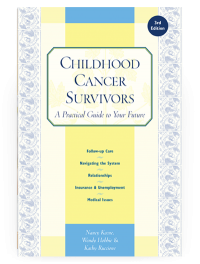Childhood Cancer Survivors
Retinoblastoma
Retinoblastoma is a malignant tumor of the retina in the eye. Approximately 300 children and adolescents younger than age 20 are diagnosed in the United States each year. Retinoblastoma usually is diagnosed in very young children and may be present at birth. Although it can occur at any age, 95 percent of cases are diagnosed before age 5. Children with more than one tumor or a tumor in both eyes (usually the hereditary form) tend to be diagnosed at a younger age than those with only one tumor and one eye involved (usually the non-hereditary form).
Treatment
Successful treatment of retinoblastoma depends largely on the size of the tumor and the extent of the disease. The staging system most widely used is the Intraocular Retinoblastoma System, which is based on tumor size, location, and presence of disease within the layers of the retina (called seeding).
Chemotherapy
Historically, chemotherapy was thought to have limited usefulness in treating retinoblastoma. Recently, however, chemotherapy has become the front-line treatment for selected groups of patients. Intraocular chemotherapy shrinks the tumors, which are then treated with cryotherapy and/or laser therapy. Drugs used in various combinations are vincristine (Oncovin ® ), etoposide (VP-16 or Vepesid ® ), and carboplatin (Paraplatin ® ).
Surgery and other therapies
There are several types of procedures used to treat retinoblastoma: enucleation, cryotherapy, and laser therapy. Decisions about the most appropriate treatment are made on an individual basis.
Removal of the eye (called enucleation) is a simple operation that eliminates the need for repeated examinations under anesthesia required by more conservative therapies. This step is taken only when absolutely necessary. The enucleation procedure is done under general anesthesia. In addition to removing the eye, the surgeon removes a section of the optic nerve. An orbital implant is placed into the socket immediately after the eyeball is removed.
Cryotherapy, sometimes called cryosurgery, is used to treat small primary tumors or new tumors that develop. Cryotherapy uses extreme cold applied by a small probe placed directly on the tumor. It is now often used in combination with chemotherapy and can also be used after radiation therapy.
Laser therapy, which uses infrared wavelengths of light, is sometimes used to treat small tumors.
Radiation
Retinoblastoma is a radiosensitive tumor. Radiation is used to destroy local disease while attempting to maintain vision. The two methods of radiotherapy used to treat retinoblastoma are external beam radiation and radioactive plaques. Historically, children have received a total of 3500 to 4600 cGy. Newer methods of delivering radiation are being used to try to reduce adverse long-term effects. These methods include intensity-modulated radiation therapy, stereotactic radiation therapy, and proton-beam radiation therapy (also called charged-particle radiation therapy). Radioactive plaque therapy (called brachytherapy) has been used in children with small, early stage tumors and in those with recurrent disease who have previously been treated with radiation.
Late effects
This section briefly outlines some common and uncommon late effects from treatment. Remember that you may develop none, one, or several of these problems in the months or years after treatment ends.
Bone growth. The most noticeable side effect of treatment for retinoblastoma is bone growth abnormalities around the eye, which develop after radiation to the orbit. Young children who have one or both eyes removed before age 3 may have an altered facial appearance when they mature due to the slowing of the growth of the orbit. After enucleation, a prosthesis needs to be placed and replaced periodically to foster orbital growth.
Dry eyes. A less common problem is decreased tear production, causing dry eyes and blurred vision. Some children who receive external beam radiation develop mild to severe keratitis sicca (inflammation of the cornea).
Loss of vision. Radiation can cause damage to the retina, resulting in loss of vision. Doses of 4500 cGy or below rarely result in loss of vision, but 5000 to 6000 cGy can cause retinopathy, and 6500 cGy can damage the retina and optic nerve, causing blindness. If systemic chemotherapy also is given, the risk of damage increases. Radiation-induced cataracts often occur if a child gets more than 1000 to 2000 cGy. In addition, vitreous leakage can occur near the edge of the tumor scar. For more information about these possible late effects, see Chapter 10 .
Second cancers. Children with the genetic form of retinoblastoma have an increased rate of developing second cancers, especially sarcomas, lung cancer, skin cancers, and breast cancer. For more information, see Chapter 19 .
Risk of passing on to children. Survivors with the genetic form of retinoblastoma can pass the risk on to their children. Genetic counseling prior to pregnancy can help survivors sort out their options. For more information, see Chapter 3 .
Table of Contents
All Guides- 1. Survivorship
- 2. Emotions
- 3. Relationships
- 4. Navigating the System
- 5. Staying Healthy
- 6. Diseases
- 7. Fatigue
- 8. Brain and Nerves
- 9. Hormone-Producing Glands
- 10. Eyes and Ears
- 11. Head and Neck
- 12. Heart and Blood Vessels
- 13. Lungs
- 14. Kidneys, Bladder, and Genitals
- 15. Liver, Stomach, and Intestines
- 16. Immune System
- 17. Muscles and Bones
- 18. Skin, Breasts, and Hair
- 19. Second Cancers
- 20. Homage
- Appendix A. Survivor Sketches
- Appendix B. Resources
- Appendix C. References
- Appendix D. About the Authors
- Appendix E. Childhood Cancer Guides (TM)

